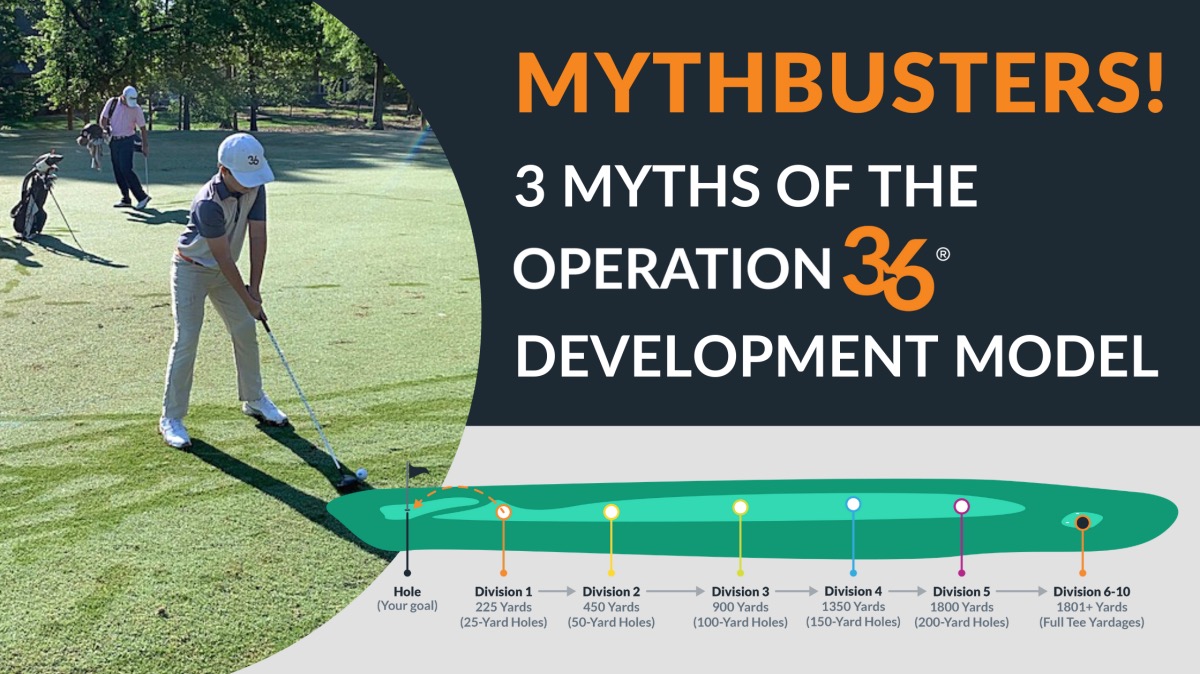
In 2003, the Discovery Channel launched one of its most popular shows, “Mythbusters.” Airing just under 300 episodes in total, the intent of the show is to test commonly held myths. If you or your kids have ever had a chance to watch, they do an incredible job of taking these myths, testing them, and in many cases shocking the audience by proving them true or false.
From time to time, we feel like we are Mythbusters at Operation 36 Golf. It’s very easy for the golf industry, coaches, parents, and players to jump to conclusions if they only hear bits and pieces of what Operation 36 was or currently is. In fairness to many, we’ve had to adapt and adjust many different facets of Operation 36 since we started in 2010. While a lot of things that we have tried worked, a few did not and we had to go back to the drawing board and start over.

To get a brief overview of our story and the lessons we have learned from 2010 to present-day go to https://operation36.golf/about-us/.
As one of the Co-founders, I have had some interesting conversations over the years and found myself in a similar myth-busting role. I find myself saying, “That’s not true” to a lot of folks and they are surprised as I then lay out why the myth they said was not true.
The fact is that the Operation 36 development model is creating golfers around the world at a staggering pace and is having an impact on families, coaches, and facilities. As of this writing, Operation 36 is being used at over 525 facilities around the world, in eight different countries and has over 49,000 users.
Here are some Operation 36 golf myths that we routinely bust:
“Shooting 120 and taking 5+ hours to play a round isn’t either.” This is how Operation 36 coach Ty Gosnell in Mount Pleasant, SC responds to his members who question the concept and effectiveness of the development program. The members then nod in agreement and more often than not, ask for his guidance.
The Operation 36 development model of starting at Division 1 - 25 yards from the green with a goal of shooting 36 or better for 9-holes is a fantastic way to build the foundation of your game. This includes both technical (chipping and putting) and human (mental, emotional and social variables) skills. And once your skills are proven to be sharp enough to shoot 36 or better you move back to the next challenge, Division 2 - 50 yards from the green.
As a coach, this approach allows us to help players in our weekly classes address specific skills that will help them score better on the course. Coaches are held accountable for our effectiveness as a coach as the player will be playing in regular 9-hole events to test their skills throughout the program. It’s truly an amazing process!
In a short period of time, players clearly understand the learning cycle of playing a 9-hole Op36 event on the course, practicing what they need to work on with their coach in class and then testing it by playing in a 9-hole Op36 event again. A player can then improve as much as they want by repeating this cycle.
Some coaches don’t like the Operation 36 development model as it holds them accountable for the progress of their students each and every week.
What!!!!????
My advice to you and your family is that you deserve better. Find a coach who cares enough about you and wants to be held accountable for your improvement.
This myth is almost never brought up when talking to beginner golfers and families that have never played golf before. When we explain to beginners that we are going to:
The most common response is a confident head nod and some version of, “That makes sense. I’m going to learn the basics and have some success on the golf course. Then I’ll move back and the game will get harder the more I improve my skills. I like that.”
To help bust this myth, we need to understand there are two CLEARLY different scenarios. Competition against others and competing against yourself.
Yes, WE AGREE, competition against other players at the wrong time in a player’s development in any sport/activity can be catastrophic and can drive players to quit. Many times it is the smaller, weaker, and less advanced players that get overwhelmed by playing against bigger, stronger, and more advanced players.
I have seen the negative consequences firsthand of competing too early against others when I caddied for my son in local junior tournaments early on in his development. When he played well and finished with a medal he was super excited. However, when he had a tough round and didn’t receive a medal he wasn’t able to channel that result into motivation to want to play/practice more. He got very angry, upset and it was not a positive experience for either of us.
He wasn’t mature enough to handle the stresses and challenges of competing against others so we decided together that he would wait until he gets a little older to play in tournaments against others. He would rather play in the local Operation 36 9-hole events and compete against the course to improve his skills. Which leads us into...
Is competing at 15 months old too young? Well, I have had a chance to watch 3 kids grow up in our home and learn how to walk. Learning how to walk is a simple example of competing against yourself. I didn’t count how many times they fell down prior to learning how to walk but it was a bunch. All 3 of them were walking by the time they turned 1 or 18 months old. They were normal and nothing out of the ordinary. Toddlers fall on average 17 times/hour or 1700 times/day when learning how to walk.
At no point during their quest to learn how to walk did they show any signs that competing against themselves was a detriment to their long-term development. On the contrary, the more they competed the faster they improved. The more times they fell down, the more times they had to get up and try again. If they stopped competing and getting up, they would have never learned how to walk.
The Operation 36 development model was specifically designed for players to compete against themselves. In the 9-hole events, each player starts at Division 1 - 25 yards away from the green with a goal of shooting 36 or better.
The coach is trained to shape the narrative to the player that the goal is to figure out after each round, “How can I improve by 1 stroke the next time? What do I need to do?” This way the player can easily process the small improvement each time and then over a longer period of time they will reach the goal of shooting 36 or better.
The development model moves players back as they beat 36 to where they are eventually at the back tees at their course. However, the concept of getting 1 stroke better each time continues each and every round.
Players are NOT competing against other players. They are competing against themselves and it morphs into the players banding together to beat the course! It’s really amazing to see the positive environment this creates. Everyone in each group is cheering each other on. It’s not me against you, it’s us against the course! Don’t let the course win today!
By using the Operation 36 development model, it encourages players to want to get more reps in playing the game on the course. They are competing against themselves each week to try to improve. The more reps or 9-hole events they get in the more they will improve.
I believe in its simplest form, playing golf on the course is fun. Why? Because it makes us curious. “If I played that hole differently next time or chose a different club or worked on my putting…”
When we are curious, we are open to learning and more motivated. Why wouldn’t we want our beginner students to go on the course, experience playing the game, and developing curiosity towards learning and improving?
This myth comes from golf industry leaders that couldn’t figure out how to get beginner golfers on the course and resorted to a strategy of needing 5 lessons before you are ready to get on the course. They were scared to put beginners on the course as it might take too long, hold up normal play, and frustrate a beginner. The hope was that they could cram enough information and learning into those 5 lessons to prepare someone to play golf from the tee box.
In our experience, when beginner golfers come to us they are wanting to learn to play the game of golf on the course. They are looking for guidance and it is our job to direct them in the most effective path to learning and progressing in the game. We feel like the most effective strategy is to get them on the course in their first few experiences to see if they enjoy the experience. If they do and they become more curious, they are now motivated to play more and take more classes to improve.
The Operation 36 development model allows them to go on the course as a beginner and have a great experience. Players do not take too long, hold up play, and get frustrated. On the contrary, they play fast, push play on the course to be faster and experience enough success that they want to come back and do it again.
The longer we wait to put a player on the course, the chances that a beginning golfer will fall in love with the game decreases. It’s like someone coming for swimming lessons and we keep them on the side of the pool for 5 lessons working on their stroke, never actually letting them get in the pool. We joke sometimes in this situation that a conversation with a parent and child would go like this:
Parent: Honey, here’s a towel to dry off.
Child: Dad, I don’t need a towel.
Parent: Why?
Child: We didn’t go in the pool and get wet.
Parent: (Very confused now…) What, you didn’t get in the pool, this is the 5th time you’ve been to swimming lessons.
If you’d like to connect with a coach that believes in the Operation 36 development model near you, visit https://operation36golf.com/#community-map.
To download our FREE “Getting into Golf Guide,” that will help those families that are just starting out in the game of golf, go to, https://operation36.golf/#getting-into-golf.
If you would like to know what it is like for juniors to advance through the Operation 36 program, be sure to check out our new YouTube series, “My Journey.”


